March 20, 2009
Air Date: March 20, 2009
FULL SHOW
SEGMENTS
Anti-Antibiotics
View the page for this story
Seventy percent of the antibiotics used in the U.S. are fed to healthy livestock. It helps to fatten them up and prevents illness. But a new bill would limit their use to sick animals to prevent antibiotic resistance. Representative Louise Slaughter, a Democratic from New York, is sponsoring the legislation and speaks with host Bruce Gellerman. (05:10)
Birds in Freefall
/ Jeff YoungView the page for this story
A new large-scale report finds roughly a quarter of all American bird species, in a variety of habitats, are in decline. But there are a few bright spots that point to potential for a turnaround. Living on Earth’s Jeff Young went visit Conn Island in the Potomac River and has our story. (06:50)
Note on Emerging Science
/ Liz GrossView the page for this story
Scientists are tapping the energy of scurrying hamsters to generate electricity. Liz Gross reports. (02:15)
My Fuel's Cleaner Than Yours
View the page for this story
California has a strict climate emissions law, and now it's turning its attention to fuels. The state may soon require refiners to reduce carbon in fuels ten percent by 2020. Anthony Eggert, Senior Science Advisor with the California Air Resources Board, explains the new carbon calculations to host Bruce Gellerman. Catherine Reheis-Boyd of the Western States Petroleum Association explains what this will mean for industry. (08:00)
Revenge of the Norwegians
/ Ingrid LobetView the page for this story
A Norwegian car company wants to manufacture an affordable, all-electric highway car in the United States. This wouldn’t be the first time a car company tried to market an electric car in this country. Living on Earth’s Ingrid Lobet reports. (03:40)
Red Robin
View the page for this story
The robins came back too soon, says writer Mark Seth Lender, and found few food options. (03:00)
Water and Women in Kenya
View the page for this story
In much of the developing world, women and girls walk miles each day to find water. One woman from Kenya seeks to change that. Deborah Katina founded the group “Yang’at” or “care” which has partnered with the World Church Service to introduce a simple method of catching water in the rainy season and conserving it for drier times. (06:20)
The Tree Trade
View the page for this story
Author Jack McEnany spent a year trying to learn how to fell trees with some of New England's toughest loggers. His new book, Brush Cat - On Trees, The Wood Economy, and the Most Dangerous Job in World, profiles a rugged group of conservationists. He spoke with host Bruce Gellerman. (09:00)
This week's EarthEar selection
listen /
download
Bird Songs of Mexico, Yucatan Peninsula
Show Credits and Funders
Show Transcript
Host: Bruce Gellerman
Guests: Catherine Reheis Boyd, Deborah Katina, Anthony Eggert, Jack McEnany, and Representative Louise Slaughter
Reporters: Ingrid Lobet, Jeff Young
Commentator: Mark Seth Lender
Note: Liz Gross
[THEME]
GELLERMAN: From Public Radio International - this is Living on Earth.
[THEME]
GELLERMAN: I’m Bruce Gellerman.
The overuse of antibiotics is enough to make you sick:
SLAUGHTER: Seventy percent of all the antibiotics produced in the United States go for animal feed and making bacteria resistant so that when human beings need it they’re not really very effective.
GELLERMAN: A new bill would prohibit feeding antibiotics to healthy animals - to save the drugs for sick people.
Also, the threat from invasive species has conservationists taking habitats under their wing.
MEHLMAN: Nonnative plants come in and can totally alter habitat type so it's unusable by birds and other wildlife.
GELLERMAN: And a would be logger sings the praises of virtuosos of the forest.
MACENANY: You know, it’s sort of like making violins – you don’t pick it up in your 40s – it’s very complicated to make a living as a logger.
GELLERMAN: These stories - and more - this week on Living on Earth! Stick around.
[MUSIC: Boards Of Canada “Zoetrope” from “In A Beautiful Place Out In The Country” (Warp Records 2000)]
ANNOUNCER: Support for Living on Earth comes from the National Science Foundation and Stonyfield Farm.
Anti-Antibiotics
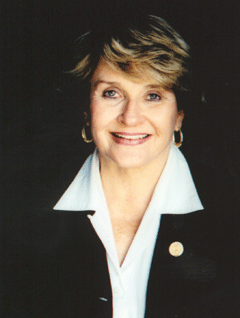
New York Congresswoman Louise Slaughter.
GELLERMAN: From the Jennifer and Ted Stanley Studios in Somerville, Massachusetts - this is Living on Earth. I’m Bruce Gellerman, in for Steve Curwood.
A public health crisis – that’s what the Infectious Diseases Society of America is calling the losing battle against deadly bacteria. The bugs are increasingly resistant to our best drugs. Antibiotics are losing their punch, largely from over use. In fact, these days hospital acquired infections kill more people each year than HIV/AIDS. And we’re running out of choices; the last time the FDA approved a new antibiotic was back in 2003.
The vast majority of antibiotics aren’t used on people - they’re fed to farm animals to make them grow faster – or keep them healthy under stressful conditions. Last year farm animals in North Carolina alone consumed more antibiotics than were prescribed for all the people in the United States.
Representative Louise Slaughter says that’s got to stop. The New York Democrat has introduced a bill in Congress to limit the use of antibiotics on the farm. It’s called the Preservation of Antibiotics for Medical Treatment Act.
SLAUGHTER: We need this act because seventy percent of all the antibiotics produced in the United States go for animal feed and making bacteria resistant. So when human beings need it, they’re not really very effective. We’re finding that people who go to the hospital, seventy percent* of them will get some kind of a bacterial infection that is resistant and the estimate is that the hospital costs and the health care costs are between four and five billion dollars annually.
(*LOE FACT CHECK: According to the Agency for Healthcare Research and Quality (AHRQ) at the Department of Health & Human Services, five percent of people who check in to a hospital in a year contract a bacterial infections; the Centers for Disease Control and Prevention states “more than 70 percent of the bacteria that cause hospital-associated infections are resistant to at least one of the drugs most commonly used to treat them.”).
GELLERMAN: So, they give these antibiotics to healthy animals…
SLAUGHTER: They give it to them in feed. Healthy animals - not to treat illness because we certainly want that done – but healthy animals as a preventative measure and to cover up some pretty awful conditions, living conditions and unsanitary conditions.

New York Congresswoman Louise Slaughter.
GELLERMAN: It’s survival of the fittest for the microbes, that is, they get stronger because they …
SLAUGHTER: They get stronger. And the best example of that is Staphylococcus aureus which causes MRSA now. But when I was a microbiology student in Kentucky, Staphylococcus aureus was as common as dirt, literally and was not anything anybody worried about because of the antibiotic being able to take it out almost immediately. But about ten, twelve years ago, we noticed that a thing called staph infection, which happened often to people who’d undergone surgery. And a lot of hospitals had to tear down their enter surgical wing and rebuild it because of the staph infection within the walls and within that unit. That should have scared us half to death. But it didn’t. And now we’re to the point where there’s MRSA, which is the methicillin-resistant Staphylococcus aureus which killed 18,000 people last year.
GELLERMAN: What exactly would your bill do?
SLAUGHTER: My bill would require the manufacturer of the antibiotic to say that if they were using it on animals, it would not create resistance that would hurt treating of human beings, and, basically, what it says is you have to only use this to treat sick animals.
GELLERMAN: What kind of resistance have you gotten from, you know, from the farm industry?
SLAUGHTER: Well, let me tell you that this is the fourth term that this bill has been introduced, not been able to pass it. We have high hopes for it this year. But I should tell you also that in 1980, a bill was introduced that would have prevented this. Had we passed it then in 1980, look how far ahead we would have been.
GELLERMAN: Well, it seems that Europe and South Korea have already got regulations. California’s considering a bill.
SLAUGHTER: Yes. And I think this is long overdue. It was just very difficult to pass.
GELLERMAN: So, why now? What was changed do you think?
SLAUGHTER: A new president. New agencies. The FDA always to me was the gold standard of health as a microbiologist and a masters in public health, but no longer. And it’s not the fault of the scientists there, ‘cause I’ve had scientists look right at me and tell me that they can’t talk about what’s really true.
GELLERMAN: I noticed that a lot of chicken companies in the United States have started giving up voluntarily the use of antibiotics.
SLAUGHTER: Yes, I think a lot of people have – mostly because people have, as I said a while ago – this is an entirely new population of thought than we had even four years ago of people who are much more aware. Because of the deaths and the peanut butter scare and the other things – meat recalls – and all the things that they’ve seen, I think they understand that their food supply’s not safe. And that’s one of the least things that they could have always been able to expect from us. And it is our job here to make sure that they are safe. So I think this bill will pass much easier and quicklier now. Senator Kennedy will be carrying it in the Senate. We never predict the Senate’s actions, but I believe it will pass the House handily.
GELLERMAN: Well, Congresswoman Slaughter, thank you very much.
SLAUGHTER: You’re welcome.
GELLERMAN: Congresswoman and microbiologist Louise Slaughter of New York.
Related link:
Congresswoman Slaughter on Antibiotics
Birds in Freefall
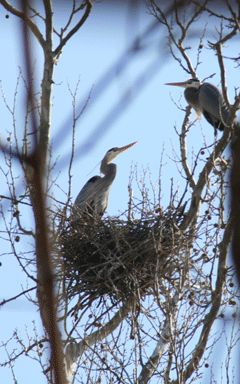
Great Blue Herons crowd the treetops on tiny Conn Island in the Potomac, not far from Washington, D.C. Herons are among the wetland species doing well—a bright spot among a sea of bad news about bird populations.
[SOUND OF RED COCKADE WOODPECKER]
GELLERMAN: The Red Cockaded Woodpecker – is a year-round resident of mature southern pine forests in the U.S.
But now it’s listed as endangered.
[SOUND OF RED COCKADED WOODPECKER]
GELLERMAN: A new report on America’s birds indicates many populations are in free
fall - over the last 40 years there have been dramatic declines in native species living in grassland, ocean and desert habitats. But not all is grim - as Living on Earth’s Jeff Young learned recently when he went birding not far from the nation’s capital.
[SOUND OF WALKING THROUGH BRUSH]
YOUNG: Conn Island is a couple hundred muddy acres in the middle of the Potomac River. In summer it’s covered with stinging nettles. And it frequently floods. But some consider Conn Island prime real estate.
MEHLMAN: It’s good news I spotted an adult bald eagle.
YOUNG: That’s Nature Conservancy bird expert David Mehlman who’s just caught our national bird in his binoculars. Mehlman recalls when that would have been a rarity. The bald eagle spent 40 years on the list of threatened and endangered species.
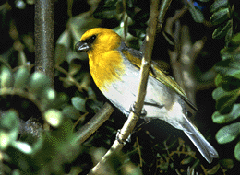
The endangered Palila of Hawaii¹s high mountains. Hawaii is home to one-third of all the birds on the U.S. list of endangered and threatened species. (Courtesy of the US Fish and Wildlife Service)
MEHLMAN: When I was a teenager eagles were very rare around here, in fact didn’t nest in Washington, DC area at all. But thanks to environmental improvement banning DDT and special legislation actually that protected eagles we’ve seen an enormous increase in eagles around the whole wider Chesapeake Bay area.
[SOUND OF WOODS]
YOUNG: It’s the kind of positive news Mehlman’s eager to accentuate, even when so much of the news in the State of the Birds report he helped to write is so gloomy. Federal and state agencies teamed with five conservation groups to dig into 40 years of data from breeding bird and waterfowl surveys and the Christmas bird counts. They used new statistical methods to find trends among birds according to habitat. Of the roughly 800 bird species in the country about 200 are in trouble.
Wetlands species provide one of the few bright spots. And Conn Island is proof. It’s not just the eagles. The island’s also an important nesting site for great blue herons. Mary Travaglini manages habitat restoration here for The Nature Conservancy.
TRAVAGLINI: Well two years ago when we were out here we counted 184 nests. The fact that we have so many herons here and they’re still here is rather interesting and I don’t know if that has to do with the fact that this island floods and that regenerates the soils. But a lot of heron rookeries actually essentially kill their own habitats with their droppings. The droppings are so intense and essentially toxic to the soil that they’ll end up killing the trees that their nests are in.
YOUNG: Boy they’re just like us: they want a quiet spot with a lot of food to raise their young and then they end up spoiling it with their own waste.
TRAVAGLINI: That’s right. Good point [laughs].

Great Blue Herons crowd the treetops on tiny Conn Island in the Potomac, not far from Washington, D.C. Herons are among the wetland species doing well—a bright spot among a sea of bad news about bird populations.
MEHLMAN: Let’s say each nest is like four birds, let’s do some math, that’s over 700 birds in a small area over months that’s a lot of bird droppings.
YOUNG: Alright I’m getting out my cap [laughter].
Now properly attired we venture forth.
So I’m just underneath the colony of the herons. They’re nesting way up high in the tops of sycamore trees.
[CROAKING SOUNDS]
YOUNG: Look at that it’s a heron condo up there!
MEHLMAN: I’d have to say close to 50 nests easily visible right from this point and we’re starting to hear some of the croaks and growls of the herons.
[CROAKING SOUNDS]
YOUNG: The scientists are constantly vigilant against any threats to the heron habitat. Travaglini pulls up a cluster of green from the sandy soil.
TRAVAGLINI: It’s called Star of Bethlehem it’s an exotic garden plant that’s invasive around here so I tend to grab it when I see it. [laughs].
YOUNG: So what’s the role of exotic invasives and bird populations?
MEHLMAN: Exotics or invasive species are one of the top threats to biodiversity of all kinds worldwide including birds. Non-native plants come in and can totally alter habitat type so it’s unsuitable for use by birds and other wildlife.
[SOUND OF WALKING THROUGH BRUSH]
YOUNG: The report shows invasive species, habitat loss and fragmentation, pesticides and disease all taking a tremendous toll on birds.
Arid land species like the Gunnison sage grouse fell 30 percent; grassland species like the northern bobwhite 40 percent due to sprawling development and agriculture.
Ocean species dropped almost 40 percent perhaps an indictor of much deeper problems with ocean food supplies. And despite recent gains in western and northern forests, the country’s eastern forest songbirds dropped by a quarter.
.gif)
Nature Conservancy bird expert David Mehlman on the lookout for coots,cormorants, eagles and herons that abound on this stretch of the Potomac:
"If we can do for other bird habitats what we've done for wetlands then I think there's reason for optimism."
WALLACE: Right now Hawaii has the dubious distinction of having had more avian extinctions since 1500 than any other place on earth.
YOUNG: Hawaii’s uniquely adapted species face an additional threat: avian malaria, which could expand higher into Hawaii’s mountains with climate change.
Of all the US birds on the threatened and endangered species list, Wallace says one third are in Hawaii. Yet only about four percent of government funding for recovery goes there.
WALLACE: We have species like the Palila with a population of only about 2,000 birds. We have species like the Maui parrot bill with a population of only about 500 individuals. These are some of the most endangered birds, indeed, not just in the US but on the planet and I think it’s important for this country to take action to prevent future extinctions.
YOUNG: The American Bird Conservancy also wants the Obama administration to reverse some Bush-era decisions on old growth logging in the Pacific Northwest to better protect the northern spotted owl and marbled murrelet.
The recommendations from the State of the Birds report are much broader than that. The authors encourage more public involvement in birding and more public and private money for conservation.
[SOUNDS OF WALKING THROUGH BRUSH]
YOUNG: And back on Conn island in the Potomac, David Mehlman has another recommendation: Don’t lose hope.
MEHLMAN: We do see signs that a change is possible. And these are wonderful testimonials to the success of what we can do if we put our minds and our dollars and our work to conservation. And we’re looking right here at two examples of that: the bald eagle and great blue heron. Couldn’t ask for better examples.
YOUNG: Mehlman and his colleagues found two bald eagle nests and 187 blue heron nests just here on tiny Conn Island. More reasons for optimism to take wing.
For Living on Earth I’m Jeff Young on the Potomac River in Maryland.
Related links:
- Read the entire report
- More on the stretch of the Potomac River Jeff visited, and conservation efforts there
[MUSIC: A Setting Sun “The Sunshine Mind” from Empty Sound ((Moongadget Records 2008)]
GELLERMAN: Just ahead – California counts the carbs in carbon fuels. Keep listening to Living on Earth!
[MUSIC: John Scofield “But I Like The Message” from Piety Street (Emarcy Records 2009)]
Note on Emerging Science
[SOUND OF HAMSTER WHEEL]
GROSS: We’ve all heard of horsepower – but hamster power? By just running around in their wheels, these furry little guys are making some big strides forward in renewable energy.
[THEME]
GROSS: A team of researchers and engineers at Georgia Tech used nanotechnology to convert the energy from a scurrying hamster into electricity.
This is not the first time biomechanical energy – the energy from the movement of humans and animals – has been harnessed. One nightclub in England recently installed an energy-generating dance floor, with lights powered by pounding feet. But what the Georgia Tech study shows - is that even small amounts of irregular movement, like a tapping finger, can be converted into electricity.
And hamsters are mini diesel engines of biomechanical energy. Anyone who’s ever tried to sleep in the same room as their pet hamster knows – the tiny rodents can happily run all night long.
To tap this energy, researchers outfitted the hamsters in yellow rodent-sized jackets with four nanogenerators attached. These nanogenerators contained zinc oxide wires a hundred times thinner than a human hair. As the hamster ran, the wires repeatedly flexed and released – producing a measurable electric current.
Measurable, yes. But small. The hamster’s jacket generated just half a nanoamp of current. At this rate, it would take a billion hamsters just to turn on your average 60-Watt light bulb.
In the future, the researchers envision powering BlackBerrys powered by our own fingers or implanted medical devices driven by pulsing blood vessels.
It will be years before this sort of technology is available. But – in the meantime, one engineer has given his hamster another green job – turning confidential documents into fresh bedding, with a hamster-powered paper shredder.
That’s this week’s note on emerging science. I’m Liz Gross.
[MUSIC: Jonathan Richman “Hope theme” from Revolution Summer]
Just ahead – Norway plugs electric cars for US drivers – but first news of a different source of power – in this note on emerging science from Liz Gross.
My Fuel's Cleaner Than Yours

A refinery in Alaska (Courtesy of National Energy Technology Lab)
GELLERMAN: It’s Living on Earth, I’m Bruce Gellerman.
Reducing greenhouse gas emissions isn’t just a good idea – in California, it’s the law. The state is the first in the nation to go on a low carb diet. Three years ago it passed legislation restricting the release of climate change gases across its economy.
Now, it’s come up with detailed formulas that producers of transportation fuels must use to count all of the carbon in their products. It’s a market based mechanism designed to dramatically cut the state’s carbon footprint says Anthony Eggert. He’s Senior Policy Advisor with the California Air Resources Board.
EGGERT: The basics of the low carbon fuel standard is to reduce the carbon intensity of transportation fuels by ten percent by the year 2020. And what that means is that for all of the fuels that are sold within the state, we assign different values of carbon associated with those fuels based on their full lifecycle emissions profile. Lifecycle emissions are the total emissions that are released throughout a fuel’s full lifecycle, which includes, for example, for petroleum it would be the extraction from the well, processing in the refinery, and the distribution and eventual burning in a combustion engine.
GELLERMAN: So if fuel producers have to reduce the amount of greenhouse gases that are kind of embodied in their products, that means you’ve gotta calculate how much carbon is involved in every type of vehicle fuel?
EGGERT: Yeah, that’s correct. This basically embodies what’s called lifecycle analysis. To really make an accurate accounting of what the total impact of producing those fuels from the well head to wheel – or in the case of biofuel, from field to wheel - and make a calculation at each step and figured out what the contribution of each of those steps to its total greenhouse gas emissions profile. We believe this is probably the most comprehensive attempt at doing this full lifecycle accounting and using it for the purposes of a performance standard for regulating vehicle fuels.
GELLERMAN: So this performance standard for producers – that’s producers of fuel for vehicles – there’re gonna be winners and losers, I guess. Who are the lucky fuel producers who are going to come out ahead and who are the unlucky ones?

A refinery in Alaska (Courtesy of National Energy Technology Lab)
EGGERT: The winners are any fuel provider that can produce a fuel that beats basically petroleum. So, for example, an advanced biofuel that uses a cellulose waste feedstock, some of these advanced biofuels can achieve 60, 70, 80 percent reduction in lifecycle greenhouse gas emissions. In addition to that, electricity – we hope to see more electric vehicles here within the state, using either electricity or hydrogen, both of which score very well in terms of their carbon intensity as a fuel.
GELLERMAN: So which fuels are the unlucky ones, the losers in this?
EGGERT: The fuels that are, I guess, you know, going to face a significant disadvantage are the coal to liquids. When you produce a liquid fuel from coal without taking steps to, for example, sequester the carbon, the emissions can be double that of gasoline. Also, we’re taking a very close look at the oil sands from Alberta and the processing that’s required to extract and turn those oil sands into a transportation fuel, in many cases results in higher emissions than today’s conventional petroleum.
I would also say that, you know, biofuels is a very interesting area for analysis because there are biofuels that have emissions that are greater than gasoline and there are biofuels that have emissions that are substantially lower than gasoline. And this rule is structured in such a way that allows us to see those differences and to properly account for them.
GELLERMAN: So how do you expect major refiners to meet this new California standard?
EGGERT: The way we expect that the refiners will meet the standard is blending increasing amounts of low carbon biofuels, especially as these more advanced biofuels come online. Over the mid and long term, an increasing number and quantity of things like electricity, hydrogen and perhaps natural gas – all of these will generate credits for the refiners to use to comply with the standard. You know, what we’re trying to affect here is really a complete transformation of our transportation energy system. To achieve our 2050 goals for greenhouse gas emissions, which the governor has set out eighty percent below 1990 levels by 2050, really requires that we completely transform and de-carbonize our transportation energy system.
GELLERMAN: Anthony Eggert is Science and Technology Adviser at the California Air Resources Board in Sacramento. Mr. Eggert, thank you very much.
EGGERT: Thank you very much for having me.
GELLERMAN: Well, it’s one thing to require the makers of transportation fuels to meet stricter standards, but it’s up to the companies to figure out how. And they’ve got about a month to respond to California’s proposed rule.
Catherine Reheis Boyd represents refiners and oil and gas companies in six western states including California. She's executive vice president of WSPA, the Western States Petroleum Association.
Hi Ms. Reheis Boyd.
BOYD: Thank you for having me.
GELLERMAN: So, you know the standard. How are your members going to reduce the amount of carbon in California fuels by what – ten percent – by 2020?
BOYD: Yes. It is probably the most transforming fuel regulation ever envisioned by the California Resources Board. And – while it will be a big challenge – as you can imagine when you’re dealing with people driving their cars and trying to get from A to B every day, they are going to need sufficient quantities of fuel, and they’re going to need them to be reliable and affordable. So, whatever we do as refiners, we have to insure that the consumers are satisfied, or the program will not succeed. So, that’s where we need to start with what is cost effective and what types of fuels are available.
GELLERMAN: So, what kind of fuels are going to be available? What are you going to do?
BOYD: Well you have several choices as refiners, and one of those is to blend into your gasoline and diesel a biofuel which would supposedly reduce its carbon intensity. And the choices we have at this point in time are corn-based ethanol. And corn-based ethanol in some cases, benefits climate change and in other cases it does not. And so it isn’t the silver bullet that they had hoped for. The other types of fuels that will be available in the future will be things like cellulosic ethanol, that is ethanol that doesn’t have a lot of emissions associated with its planting and harvesting, because it’s the biomass, it’s the byproducts of these different types of ethanol crops. Problem is, it’s not available yet, and we’re very worried that it won’t be in sufficient quantities to meet the regulation in the timelines that have been outlined.
GELLERMAN: So, can you make this law work?
BOYD: Well, we don’t know yet, is the honest answer. Obviously we’re going to be bound to compliance and if we don’t, we – there are very strict enforcement penalties. And so the challenge for us is to figure out a way to make this work. One thing we think is very important for the Air Resources Board to include in this regulation which, by the way, is 700 pages in length and we have 45 days to an adoption hearing – but if they don’t include in the regulation some very definite periodic reviews as we go forward to 2020, we get very concerned about the uncertainty and the ramifications of that uncertainty to the ability of people to be mobile. And cost is extremely important in the economic analysis that was just released as well – comes to the conclusion that this is economic, it’s cost effective, it can be achieved at no cost to the consumer. Now, being in this business for 22 years and being through three formulations of gasoline, that has never occurred, and that has been on gasoline and diesel reformulations that we know of, that we are familiar with. Here we’re talking about fuels that haven’t even been envisioned yet, haven’t even been invented in some cases. And certainly in the quantities that will be needed to reach these targets. So we are very concerned and certainly we’re hoping for more time than 45 days.
GELLERMAN: Well Ms. Reheis Boyd, thank you very much.
BOYD: Thank you.
GELLERMAN: Catherine Reheis Boyd is Executive Vice President of the Western States Petroleum Association. She joined us from our bureau in Los Angeles.
Related links:
- California Air Resources Board Low Carbon Fuel page
- Governor Schwarzenegger's Low Carbon Fuel page
- Western States Petroleum Association on Low Carbon Fuel
Revenge of the Norwegians

The Th!nk City car may be built in the US (Courtesy of Th!nk Global)
GELLERMAN: A small company in Norway has big plans on the drawing board to build plug in electric cars in the United States.
The car called TH!NK - with an exclamation point in place of the “I” - faces an uphill climb, but as Living on Earth's Ingrid Lobet reports, it just might be the little engine that could.
LOBET: Back in 1990 air quality officials in California demanded that automakers build a certain number of electric cars to cut down on tailpipe emissions and reduce hazardous smog.

The Th!nk City car may be built in the US (Courtesy of Th!nk Global)
Automakers fought back, producing as few electric cars as possible. Ford Motor Company turned to Norway to satisfy its requirement, purchasing a line of cars called Th!nk. But car makers continued to press the case that battery technology wasn't good enough, and in 2003 they persuaded California officials to back off the electric car requirement. Ford immediately sold the electric Th!nk division back to the Norwegians. Other automakers crushed their cars.
But the Th!nk refused to die. The Norwegian Company "Think Global," is now looking to employ 300 Americans building Th!nk vehicles in the United States. New auto jobs? In the US? CEO Richard Canny says yes.
CANNY: We plan to produce the Think City in one of the states in the United States and then go on sale in 2010.
LOBET: Forget those souped up golf carts. The Th!nk City is an electric car that will go on the highway and seat four, or if you fold down the rear seats and open the hatch, two plus trunk space.
CANNY: Th!nk City is bigger than a smart car and smaller than most other cars on the US market today. It is fully electric. And it can go 112 miles on a single charge. The US version will have a top speed of 70 miles per hour.

Th!nk Global is looking for a place to build this Th!nk City car in the US (Courtesy of Th!ink Global)
LOBET: And that's about the speed Th!nk was moving when it hit a wall last fall, just as it was trying to ramp up production. Gasoline was over four dollars a gallon. The electric business was golden. Then all of a sudden credit to buy new equipment and pay new workers evaporated. Th!nk's suppliers wanted payment early. Th!nk was forced to reorganize. Building a plant in the United States is part of its reorganization plan. Richard Canny says the global moves to cut carbon emissions and the new administration in Washington are both favorable.
CANNY: Well I think all of a sudden the US has moved from being far behind in the field of electric vehicles to really being perhaps one of the leaders if not the leader.
LOBET: Canny cites new financial incentives for buyers and builders of clean vehicles. And he says finally, the batteries that are the beating heart of electric cars, are advancing. Environmental writer Jim Motavalli agrees.
MONTAVALLI: I do think batteries are advancing quite rapidly and it’s gotten to the point where most people really see we’re going to replace internal combustion engines with electric.
LOBET: Detroit automakers, especially Chrysler, have announced more electrically driven cars, most of them hybrids.
MONTAVALLI: Detroit will definitely follow the same path as foreign automakers like Th!nk. Whether they have the financing to produce the cars in unclear.
LOBET: Which is why low interest government loans in the US and elsewhere are crucial for companies like Th!nk. And for anyone hoping to someday, someday soon, walk into a dealership and buy an affordable car that needs little or no gasoline.
For Living On Earth, I'm Ingrid Lobet.
Related link:
Th!nk Global Electric Cars
[MUSIC: Fareed Haque “Fur Peace” from Flat Planet (Owl Studios 2009)]
Red Robin
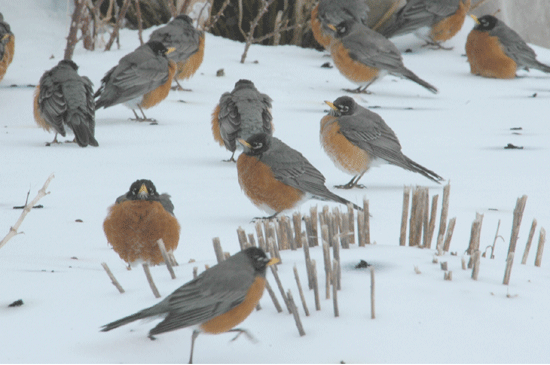
(Courtesy of Salt Marsh Diary (c))
GELLERMAN: The red red robins have come bob-bob-bobbin’ back to the backyard of writer Mark Seth Lender.
But this year – the birds came back a bit too early. So they’ll just have to make do with what they find.
LENDER: Robins have arrived in the snow. Not the kind of snow you can peck through or scratch away. Snow like a salt glaze, bluish white, pebbly and shiny and slick as glass. They skip and skid upon the unexpected hardness of early Spring. This is what the robins have arrived to.
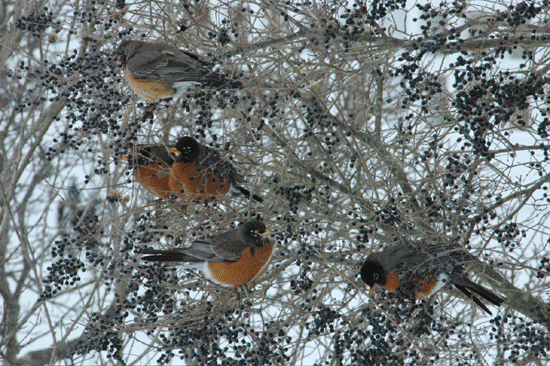
(Salt Marsh Diary (c))
There are at least a hundred. They blanket the yard like the snow they prance upon, snow that fell here on the coast only in inches, followed by hours of fine freezing hail. Where will they hide? In bushes without leaves? In trees with bare branches? What will they eat, these tuggers of worms, when all the worms in the world are fast asleep? Even if the tiny treading footsteps of the birds awakened them, could soft-bodied annelids, pushing and prodding and innocuous, crack that locked earthen door much less the icy clasp?
Between my yard and the next is a row of feral privet bushes. Feral because if they’ve ever been trimmed it was not by me. True confession? I hate privet. Hate the way it smells, the way it looks. What possible good could those ugly blue-black berries do if at the end of a long hard winter they are still there, dangling, a basket of stone fruit ignored by every hungry mouth to come this way all these starving months and days.
Except, that is exactly what the Robins are doing here. They are eating the inedible.

(Salt Marsh Diary (c))
It is not as if it doesn’t affect them. They stand dumbfounded on the snow, feathers bulging against cold and the apparent discomfort of what they have just consumed. It passes through them quickly or simply refuses to stay down. Purple stains spread against the whiteness. Yet, perched in the bushes or hopping between to find what has fallen, they eat until there is nothing left, not a single berry. And the next time I look, the robins have gone.
It is as if they have vanished. They are not on the road; not in the woods; none fly. Walking the edge of the salt marsh I pause and think perhaps like rats gorged on rat bane they have been driven to the river in desperate thirst and drowned there. But it is not illness. Only the hour has carried them away, that universal hour, that vacancy just before sleep.
The marsh is silent as a pillow. Inhaling, the air still tastes like winter but a robins show, You don’t need a weatherman to know which way the wind blows.
GELLERMAN: Mark Seth Lender writes a syndicated column called “Salt Marsh Diary.” You can see some of his photos and find out more about his writing at our website: loe.org.
Related link:
Salt Marsh Diary
[MUSIC: Ed Matzenik “Subterranean Homesick Blues” from Psycedelic Guitars (edmatzenik@hotmail.com 2008)]
Just ahead – the most dangerous job in America – it’s probably not what you think. That’s coming up - on Living on Earth.
ANNOUNCER: Support for the Environmental Health Desk at Living on Earth comes from the Cedar Tree Foundation. Support also comes from the Richard and Rhoda Goldman fund for coverage of population and the environment. ..and from Gilman Ordway for coverage of conservation and environmental change. This is Living on Earth on PRI, Public Radio International.
[MUSIC: Fareed Haque: “Uneven Mantra” from Flat Planet (Owl Studios 2009)]
Water and Women in Kenya
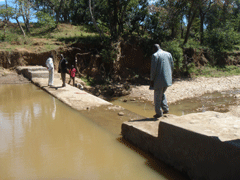
Sand dam at Akiriamet village, West Pokot, Kenya: opening ceremony, April 2008 - full from the long rains, before the onslaught of a prolonged drought. (Church World Service)
GELLERMAN: It's Living on Earth, I'm Bruce Gellerman.
Water isn’t only about quenching thirst or growing plants - it’s also a gender issue. In many parts of the developing world finding and carrying water is woman’s work. Water as a gender issue is one focus of the UN World Water Day, observed each year on March 22nd.
Deborah Katina traveled from Kenya to the United States to observe the day. She’s the founder of the organization “Yang’at”. With the help of Church World Service, it’s constructing what are called Sand Dams - low cost reservoirs that helps make clean water available year round.
Hi Ms. Katina welcome to Living on Earth.
KATINA: Hi
GELLERMAN: So what does the name of your organization “Yang’at” mean?
KATINA: Yang’at means care, it means we care about the women and the girls.
GELLERMAN: In what language?
KATINA: Pokot
GELLERMAN: Where is that?
KATINA: In Kenya, Ristivali Province, West Pokot district.
GELLERMAN: Is that where you’re from?
KATINA: Yeah, that’s where I’m from.
GELLERMAN: Well tell me about the Pokot district, particularly in terms of water.
KATINA: Ok the Pokot district, we are nomads, so pastoralists and it’s – most of the area is arid. And people do go long distances especially women and girls, they go long distances in search of water.

Sand dam at Akiriamet village, West Pokot, Kenya: opening ceremony, April 2008 - full from the long rains, before the onslaught of a prolonged drought. (Church World Service)
GELLERMAN: How far?
KATINA: Twenty miles. Round trip.
GELLERMAN: And it’s the women and the girls who do the getting.
KATINA: Yes. The women and the girls do it. Our men just sleep.
GELLERMAN: And your organization CARE, you’re addressing the water problems, I understand.
KATINA: Yes, we’re addressing the water problems, and we’re doing the sand dams and shallow wells.
GELLERMAN: Sand dams. What are sand damns?
KATINA: Sand dams, it’s a – this is a way we block the seasonal river, because we have seasonal rivers there. So it’s a manner of blocking or building a wall across the seasonal river so that when it rains during rainy season or when we have rains we literally catch all the water instead of letting the water flow maybe to another bigger river or somewhere. But we catch all the water and it can be stored in the sand dam, which is beneath the sand, so that it can be reused during dry season. So that people can drink good, clean water.
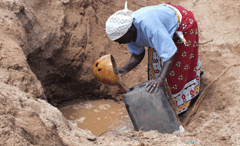
In Kenya's semi-arid West Pokot district, during droughts when the river bed is dry, women in the village near this sand dam can dig into the sand and retrieve clean water from a sub-surface reservoir. Some villages build shallow wells next to their sand dams, to hold water for human use, leaving a dam-side pool for their cattle. (Henry Coates/Church World Service)
GELLERMAN: So, if I understand this correctly the sand which accumulates on the upstream part of the river …
KATINA: Yes.
GELLERMAN: … acts as a sponge of sorts, right?
KATINA: Yeah.
GELLERMAN: And then, you put a hole in the dam and you get the water that’s stored in the sponge, even when it’s not raining.
KATINA: Yes, yes, yes.
GELLERMAN: And it works?
KATINA: It works. It really works.
GELLERMAN: How well?
KATINA: Because now we have – okay due to climate change now, okay the seasons are changing and we have maybe one rainy season with floods, a lot of floods. And then when we build that wall along the seasonal river, we can have a lot of water stored.
GELLERMAN: So part of the sand dam you turn into a shallow well.
KATINA: Yes.
GELLERMAN: So, how does the shallow well work with the sand dam?
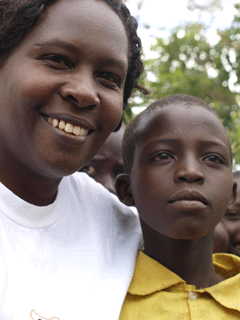
Yang'at's Deborah Katina (left), coordinator of Church World Service-supported water projects in Kenya, and Rosalyn, a top student in one West Pokot community. (Henry Coates/Church World Service)
KATINA: A shallow well will be constructed near a sand dam, because the water now has been stored and there’s water throughout. So the shallow well will be just beside there so that they can have clean water and also we can have a separate cattle trough for the animals.
GELLERMAN: How much does it cost to construct one of these sand dams?
KATINA: Okay, to construct it will need $15,000. We’ve constructed one sand dam with put up shallow well. We’ve put up the cattle trough and also the transport and all the other logistics.
GELLERMAN: You know, Deborah, you’re visiting the United States now.
KATINA: Yes.
GELLERMAN: You can turn the faucet and out comes the water. What is that like for you?
KATINA: It’s luxury. When I see water running, it’s luxury. In fact, even today in the morning I call my brother and the first thing he was complaining about was water – there’s no water. And here I am, there’s plenty of water. I can shower. And even sometimes when I walk I see people just leaving the tap on and it’s like “oh – I wish this water would be taken to Africa to, to place, it would be very nice and luxury.”
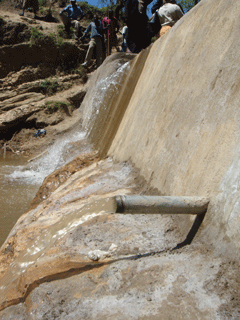
Akiriamet residents and Kenyan officials watch water from village’s new sand dam flow down to a cattle pond below. Villagers have built a nearby shallow well at the Akiriamet dam for human water consumption. (Church World Service)
GELLERMAN: Oh, I wanted to ask you: what is the blessing song?
KATINA: It’s sung by people who’ve received something or people who’ve gotten at least the water project and they’re happy and they are blessing those people who contributed something so that they can have water closer to them.
[BLESSING SONG]
GELLERMAN: And that’s sung by girls from your district?
KATINA: Yes, those are the school where we did a sand dam and shallow well, and also besides from sand dam and shallow well we did some latrines and also roof catchment tank. And they’re happy and they’re blessing the people who contributed at least something for them to have water close and then now the diseases, the water born diseases, have been reduced from that area because they can drink clean water and also sanitation issues. So those children are very happy.
GELLERMAN: Can you sing the blessing song?
KATINA: In my language?
GELLERMAN: Yeah. Are you a good singer?
KATINA: [Laughs] I am a good singer. And I can sing one in Kiswahili which says [singing in Kiswahili].
GELLERMAN: What is that?
KATINA: That is blessing. God bless you so much. Be blessed for all what you do.
GELLERMAN: Deborah Katina’s organization is called Yang’at. She’s visiting the United States and she recently won Kenya’s Head of State Commendation Award for her work with the organization that she founded.
Deborah Katina, thanks very much. It was nice talking to you.
Related link:
Church World Service
[MUSIC: Les Wanyika “Sin Makossa” from East Africa’s Finest Rumba’s & Other Styles (Earthworks 1991)]
The Tree Trade
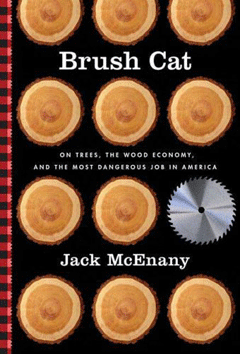
GELLERMAN: Well - from World Water Day – to World Forest Week.
The United Nations has just published its report - State of the World’s Forests 2009. The global economic slowdown has cut down the rate of deforestation worldwide, but we’re still losing nearly 30 thousand square miles of trees a year.
Forests provide habitat for a huge number of species of plants and animals - and absorb much of the world’s carbon dioxide.
In his new book Jack McEnany takes a logger's eye view of the forest and the trees. It’s called: Brush Cat: On Trees, the Wood Economy, and the Most Dangerous Job in America. Jack McEnany spent a year learning the logging trade in New Hampshire - and it’s from the studios of New Hampshire Public Radio in Concord that he joins me. Hi Jack!
MCENANY: Thank you, thank you for having me.
GELLERMAN: You know, the title - you write that you were going to call this “Brush Apes.” What’s a brush cat and what’s a brush ape?
MCENANY: Well they’re both sort of old-timey names for loggers, independent loggers who, you know, work in the woods basically by themselves. But I showed the book to one of the loggers I was working with, Bob, and he liked everything about it except the title. And he threatened to call me pencil monkey for the rest of my life if I didn’t change it.
[LAUGHING]
MCENANY: So I came up with “Brush Cat”. Bob wanted “Guardians of the Forest” which I thought was a little over the top.
GELLERMAN: Bob sounds a little over the top actually. These brush cats, these guys who are really good at it, can fell a tree within just inches of where they think it’s going to, where they want it to fall.
MCENANY: They can put it right where they want it, right where they want it. And that’s all part of the magic of being able to do it properly and making a living at it. Because, you know, if you drop it where you don’t want it to fall, it could fall on a young oak that in five years you could make you know, $1000 or $2000 from when you cut it. But if you, you know, miss by four, five inches, you just ruined a payday down the road.
GELLERMAN: I was surprised and I gotta tell you a little bit disappointed that they don’t shout “timber!” you know when the tree’s coming down.
[LAUGHING]
MCENANY: Bob always told me the best pair of eyes looking out for you are your own. He would watch out for me, but he wouldn’t guarantee that he wouldn’t drop a tree on me, because that’s how most people get hurt in the woods. It’s not a chainsaw accident, it’s a dead branch falling out of a tree. It’s a tree falling in a way that you didn’t expect because maybe it was dead inside.
GELLERMAN: You say that it’s the most dangerous job in America. I always thought that was commercial fishing.

Author Jack McEnany (Photo: Alli Gaulin)
MCENANY: Yeah, it turns out according to the Bureau of Labor Statistics, there’s 132 deaths per 100,000, I believe, for loggers and 74 deaths per 100,000 for commercial fishermen. Now, every now and then some profession like mining, you know, when the administration pulls all the OSHA regulations from the mining industry, there’ll be a spike in that particular profession for a year or so, but logging is almost twice as dangerous as commercial fishing.
GELLERMAN: Bob the logger has a list of why it’s better to log in the deep cold of winter. I wonder if you’ll go through them for us.
MCENANY: There are five advantages to working in this time of year as enumerated by Bob. 1) No bugs. 2) With all the leaves off the deciduous trees its easy to see what, if anything, is worth bush whacking. 3) The days are short and you can’t cut trees at night or at least you’re not supposed to. 4) In case of an accident, blood flows significantly slower. And 5) No bugs.
GELLERMAN: I guess even the green flies will eat you alive.
[LAUGHING]
GELLERMAN: It’s also a generational business. This is one that really has a lot of tradition and it’s handed down from father to son, principally.
MCENANY: Yeah, well, it’s, you know, it’s sorta like making violins, [laughs] you don’t pick it up in your 40s. It’s very complicated to make a living as a logger. You know, you’re a single guy or maybe two people, you know, a father and a son, and you’re out there in the woods, working alone, while on one side you have the state with lots of rules and regulations on everything about, you know, how and what you cut to the pole fords that you put across streams. On the other side you have the mills that you sell to that were locally owned operations. Now many of them, most of them, are owned by transnational corporations. Are you’re this one single guy who’s trying to make a living out of a very, very complicated situation.
GELLERMAN: You talk about skid row. I guess a skid is what you use to pull these trees out of the forest. But that’s where the notion of skid row comes from?
MCENANY: Yeah, precisely. Back, you know, in the old timer logger days when the loggers lived in camps deep in the woods and would come rowing out every two months or so with a big wad of cash in their pockets, they’d set up shop in a bar or in a brothel and stay there as long as the money lasted. And where the loggers frequented, it became to be known as skid row, because that’s the name of the roads that the loggers cut into the woods to harvest trees from. The word hooker also came from loggers. A hooker is someone who puts the chain around a hitch of logs and then pulls on it to let the skidder driver know to pull it away. And so this translated over into the brothels if a man would get hooked, although, you know, I mean honestly, who was doing the hooking, I’m not quite sure. I think I give a little too much credit to the loggers there, but that’s where the word came from.
GELLERMAN: You know we all know that woods used in everything from cutting blocks to tables to you know, paper, but you’ve got some uses here I’d never imagined that wood was used in.
MCENANY: Yeah – it’s 10,000 products and growing. Especially with the new technologies. They now can reduce wood to its basic hydrocarbons and then rebuild it so that it’s really indistinguishable from plastics except that there’s no petrochemicals involved. And, of course, the houses we live in, the furniture we sit on, often the clothes that we wear, are all made from wood, made from wood fiber.

GELLERMAN: Milkshakes?
MCENANY: Yeah, that was, that’s what really intrigued me when I first moved here in 1984. I went on a tour of the mill in Groveton and they made this stuff called wood flour. Now I thought it was pulp for paper and I asked the manager and he said no, our biggest client for this stuff is McDonalds. And he said what do you think they put it in? And I thought oh my goodness, the bread, the meat? He said non-dairy shakes. He said why do you think they’re nondairy?
[LAUGHING]
MCENANY: So, it’s all cellulose. Which I guess is good roughage.
GELLERMAN: I’m gonna have to chew that one over.
[LAUGHING]
GELLERMAN: There seems to be a big difference between the forests of New England, the northeast, and the forests of the northwest, the way they’re logged.
MCENANY: Yeah. Well, you tend to have more monoculture forests out west. And, you know, you’ll see a lot of clear cuts, because every tree that you have a contract for is the same kind of tree, so cut ‘em all. Whereas in northern New Hampshire, Vermont, upstate New York, it’s the transitional forest. You have a lot of conifers and a lot of hardwoods. Just really any kind of wood you’d want or need is in those forests. And so, in order to log them effectively, you have to cut very selectively. And leave the hardwoods behind to cut again in five or ten years when they become mature. And because you want them to mature well, you’re very careful about how you take the logs out of the woods that you are cutting, so that you don’t bark them and ruin the young trees. There’s more of an artisans approach to logging in the northeast, I think than out west.
GELLERMAN: Yeah. You refer to them as conservationists.
MCENANY: Yeah. Not all loggers, but I would say the vast majority of them are – have a much greater respect for the forests than most of us. You know they see it for what it is. It’s not only a great resource, but it is almost like people who live on a small island, the relationship that they have with the ocean. You know, the ocean gives and the ocean takes away. And that’s the way most loggers see the woods. And they’ve been really, really affected by climate change. Twenty years ago mud season began around April first. But now it begins on March first. That’s another four weeks, one twelfth of the year, during the cold months when it’s best to log, just cut out of their income. And it’s a bottom line issue for them. They don’t just [laughs] – they don’t think of it in the abstract, it’s their wallets that it hits. And Bob is actually, because the logging business has gotten so difficult in the past couple of years – Bob is thinking of using that B.S. in geology he has from Northeastern and becoming a teacher at the age of fifty years old because he can’t make a living as a logger any longer.
GELLERMAN: Can you do the accent? One of the things I like about your book is that you really, you really nail that New Hampshire accent.
MCENANY: I don’t know if I can do it without swearing. I’ll try.
[LAUGHING]
MCENANY: Noice, noice. You know, in the North Country, whenever anything good happens to you, whether it has to do with a day off from work or a new car, invariably everyone around you will look at you and say “Must be noice. Must be noice.”
[LAUGHING]
GELLERMAN: Well Jack, it was noice speaking to you.
MCENANY: Well thank you very much. It was noice speaking to you too.
GELLERMAN: Jack McEnany’s new book is “Brush Cat; On Trees, the Wood Economy, and the Most Dangerous Job in America.”
Related link:
For more on Jack McEnany and his book, click here
[MUSIC: Shaden Garett “The Lumberjack Song” from & The Stratospheres (Independent/IODA 2006)]
GELLERMAN: On the next Living on Earth: Competing coal commercials – advocates and opponents go head to head on TV.
ADS: We can be energy independent; clean coal - America’s power. Clean coal is supported by the coal industry..the most trusted name in coal.
GELLERMAN: Hearts minds and coal ads - next time on Living on Earth.
[BIRDS SINGING]
GELLERMAN: We leave you this week in Eden – El Eden Ecological Reserve in Mexico.
[BIRDS SINGING]
GELLERMAN: El Eden is a private nature reserve in the Yucatan peninsula state Quintana Roo – its mission: to protect the region’s seven tropical ecosystems. This avian soundscape, recorded in a shrubby field, can be found on the CD “Bird Songs of Mexico – Yucatan Peninsula”.
Bird Songs of Mexico, Yucatan Peninsula Volume 1
http://www.birdsongsofmexico.com/
[BIRDS SINGING]
Living on Earth is produced by the World Media Foundation. Our crew includes Ashley Ahearn, Bobby Bascomb, Eileen Bolinsky, Ingrid Lobet, Helen Palmer, Mitra Taj and Jeff Young, with help from Sarah Calkins and Marilyn Govoni. Our interns are Lindsay Breslau, Phil DiMartino, Liz Gross and Christine Parrish. Jeff Turton is our technical director. Alison Lirish Dean composed our themes. You can find us anytime at loe.org. Steve Curwood is our executive producer.
I’m Bruce Gellerman. Thanks for listening.
ANNOUNCER: Funding for Living on Earth comes from the National Science Foundation, supporting coverage of emerging science, and Stonyfield Farm: organic yogurt and smoothies. Stonyfield pays its farmers not to use artificial growth hormones on their cows. Details at stonyfield.com.
Support also comes from you our listeners, the Ford Foundation, the Town Creek Foundation, the Oak Foundation supporting coverage of climate change and marine issues; the Skoll Foundation, supporting social entrepreneurs around the world – uncommon heroes dedicated to the common good. Learn more at skoll.org; and Pax World Mutual Funds: socially and environmentally sustainable investing. Pax World: for tomorrow. On the web at paxworld.com.
ANNOUNCER2: PRI, Public Radio International.
Living on Earth wants to hear from you!
Living on Earth
62 Calef Highway, Suite 212
Lee, NH 03861
Telephone: 617-287-4121
E-mail: comments@loe.org
Newsletter [Click here]
Donate to Living on Earth!
Living on Earth is an independent media program and relies entirely on contributions from listeners and institutions supporting public service. Please donate now to preserve an independent environmental voice.
NewsletterLiving on Earth offers a weekly delivery of the show's rundown to your mailbox. Sign up for our newsletter today!
 Sailors For The Sea: Be the change you want to sea.
Sailors For The Sea: Be the change you want to sea.
 The Grantham Foundation for the Protection of the Environment: Committed to protecting and improving the health of the global environment.
The Grantham Foundation for the Protection of the Environment: Committed to protecting and improving the health of the global environment.
 Contribute to Living on Earth and receive, as our gift to you, an archival print of one of Mark Seth Lender's extraordinary wildlife photographs. Follow the link to see Mark's current collection of photographs.
Contribute to Living on Earth and receive, as our gift to you, an archival print of one of Mark Seth Lender's extraordinary wildlife photographs. Follow the link to see Mark's current collection of photographs.
 Buy a signed copy of Mark Seth Lender's book Smeagull the Seagull & support Living on Earth
Buy a signed copy of Mark Seth Lender's book Smeagull the Seagull & support Living on Earth

